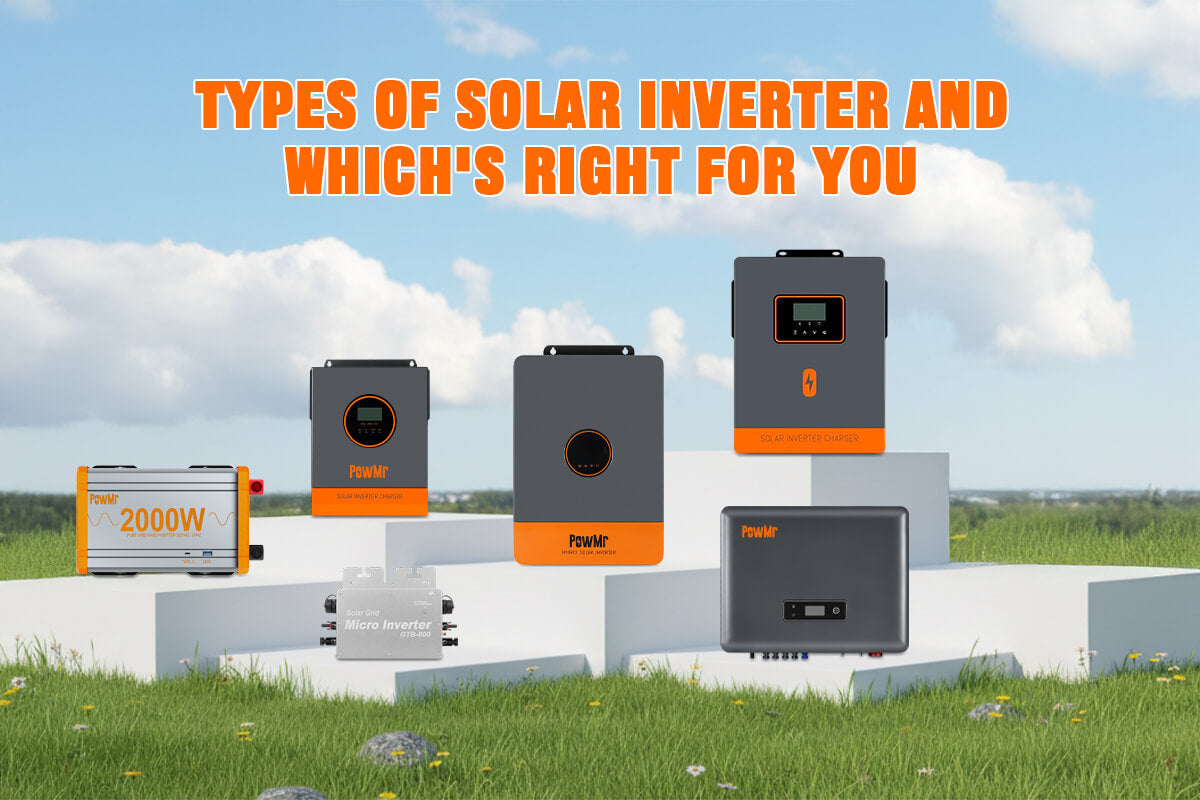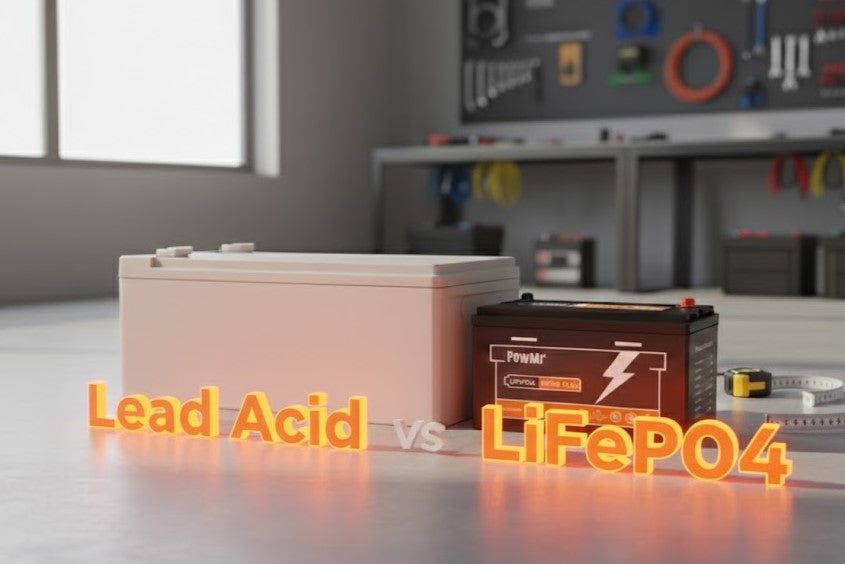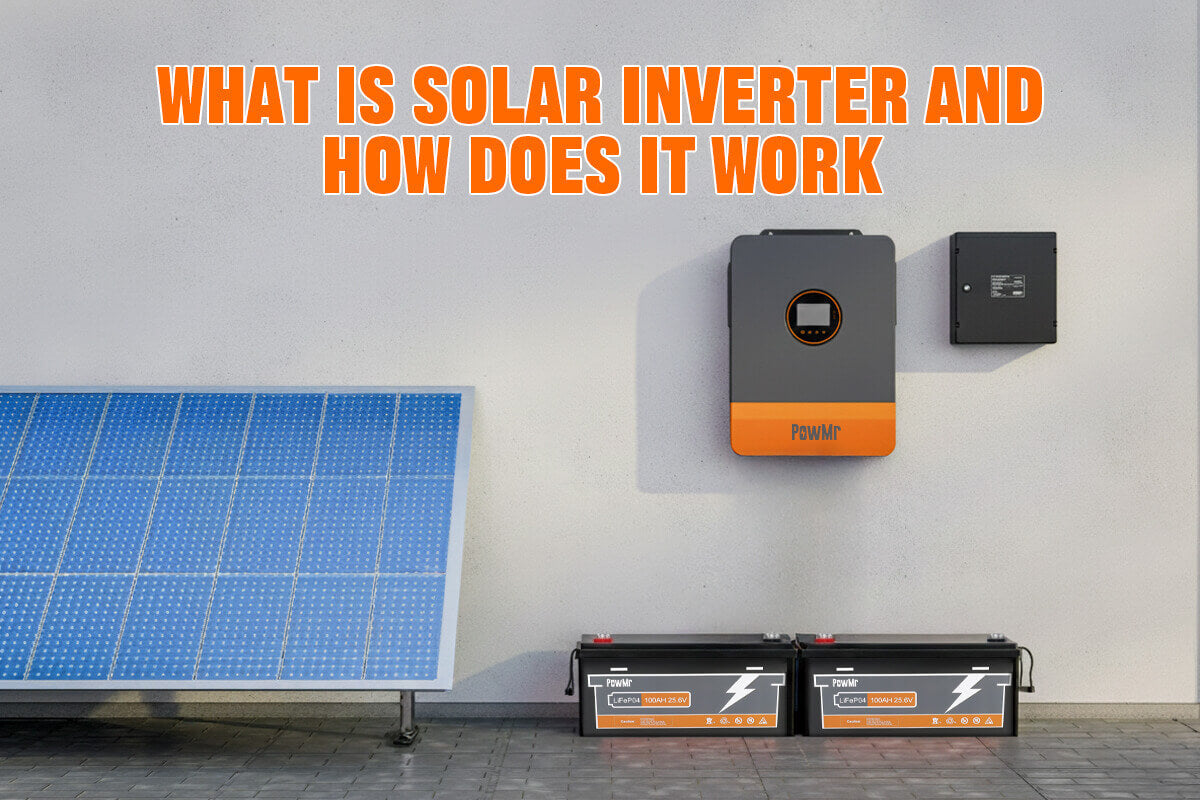ถ้าแผงโซลาร์เซลล์คือจุดเด่นของระบบโฟโตโวลตาอิก อินเวอร์เตอร์โซลาร์ก็คือสมองที่เงียบและชาญฉลาด ซึ่งควบคุมการผลิต การส่งผ่าน และการควบคุมพลังงาน พร้อมทั้งจัดการการกระจายพลังงานในระบบ เพื่อให้บรรลุเป้าหมายด้านพลังงานโซลาร์ของคุณ
เมื่อเทคโนโลยีโซลาร์พัฒนา อินเวอร์เตอร์หลากหลายรุ่นก็เข้ามาในตลาด แต่รุ่นไหนกันแน่ที่เป็นตัวเลือกที่ดีที่สุดสำหรับคุณ?
คู่มือนี้จะช่วยคลายความสงสัยเกี่ยวกับโลกของอินเวอร์เตอร์โซลาร์ เราจะเริ่มต้นด้วยสามประเภทหลักที่เจ้าของบ้านทุกคนควรรู้จัก จากนั้นเจาะลึกไปยัง การจำแนกประเภทอย่างละเอียด ที่แยกระบบที่ดีออกจากระบบที่ยอดเยี่ยม
สรุปอย่างรวดเร็ว: อินเวอร์เตอร์โซลาร์ 3 ประเภทหลัก
- อินเวอร์เตอร์แบบสตริง: มาตรฐานอุตสาหกรรมที่คุ้มค่า เหมาะสำหรับหลังคาที่เรียบง่ายและไม่มีเงา
- ไมโครอินเวอร์เตอร์: ตัวเลือกพรีเมียมที่มีอินเวอร์เตอร์สำหรับแต่ละแผง เหมาะสำหรับการเพิ่มประสิทธิภาพพลังงานบนหลังคาที่ซับซ้อนหรือมีเงาบางส่วน
- อินเวอร์เตอร์ไฮบริด: โซลูชันครบวงจรที่พร้อมสำหรับการเก็บพลังงานในแบตเตอรี่และพลังงานสำรองในอนาคต
อินเวอร์เตอร์โซลาร์สามประเภทหลักคืออะไร
อินเวอร์เตอร์โซลาร์โดยทั่วไปแบ่งออกเป็นสามประเภทหลัก ตามโครงสร้างการปรับสภาพพลังงาน ซึ่งหมายถึง วิธีที่พวกมันเชื่อมต่อกับแผงโซลาร์เซลล์และจัดการการแปลงพลังงาน และการบริหารจัดการ
อินเวอร์เตอร์แบบสตริง
อินเวอร์เตอร์แบบสตริงคืออุปกรณ์ที่ใช้ในระบบโฟโตโวลตาอิกเพื่อแปลงกระแสตรง (DC) ที่ผลิตโดยแผงโซลาร์เซลล์ให้เป็นกระแสสลับ (AC) ซึ่งสามารถใช้จ่ายไฟให้กับบ้านหรือธุรกิจได้ คำว่า "string" หมายถึงการที่อินเวอร์เตอร์เชื่อมต่อกับแผงโซลาร์เซลล์หลายแผงที่ต่อกันเป็นชุดในรูปแบบ "string"

ข้อดี:
- ต้นทุนเริ่มต้นต่ำกว่า: ด้วยส่วนประกอบน้อยกว่าและการเดินสายที่ง่ายกว่า เมื่อเทียบกับประเภทอื่นๆ string inverters เป็นวิธีที่ประหยัดที่สุดในการเริ่มต้นใช้พลังงานแสงอาทิตย์
- เทคโนโลยีที่พิสูจน์แล้วและบำรุงรักษาง่าย: ในฐานะที่เป็นเทคโนโลยีหลักของอุตสาหกรรมมาหลายทศวรรษ เทคโนโลยีนี้มีความมั่นคงและเชื่อถือได้ เนื่องจากมีเพียงหน่วยกลางเดียว การแก้ไขปัญหาจึงตรงไปตรงมา
ข้อเสีย:
- การจ่ายพลังงานที่ไม่เสถียร:หากไม่มีการรวมแบตเตอรี่การจ่ายพลังงานอาจไม่สม่ำเสมอในช่วงเวลาที่แสงแดดน้อยและสภาพอากาศไม่ดี เพิ่มการพึ่งพาโครงข่ายไฟฟ้าในช่วงเวลานั้นๆ
- ความยืดหยุ่นในการออกแบบน้อยลง: ไม่เหมาะสำหรับหลังคาที่มีหลายส่วนหันไปในทิศทางต่างกัน (เช่น ตะวันออกและตะวันตก) เพราะแต่ละสายต้องมีแผงที่หันและเอียงในทิศทางเดียวกัน
- การลดลงของการผลิตจากเงา: กำลังผลิตของสายทั้งหมดถูกจำกัดโดยแผงที่มีประสิทธิภาพต่ำที่สุด แผงเดียวที่ถูกปกคลุมบางส่วนด้วยเงา ใบไม้ หรือแม้แต่ขี้นก สามารถลดการผลิตของระบบทั้งหมดได้
- จุดล้มเหลวเดียว: หากหน่วยอินเวอร์เตอร์กลางเสีย ระบบโซลาร์เซลล์ทั้งหมดของคุณจะหยุดผลิตพลังงานจนกว่าจะซ่อมหรือเปลี่ยนหน่วย ทำให้คุณต้องพึ่งพาโครงข่ายไฟฟ้าอย่างเต็มที่
การปรับปรุงของ PowMr:
PowMr’s upgraded string inverter มีฟีเจอร์อินพุต PV คู่ ช่วยให้การออกแบบแผงโซลาร์มีความยืดหยุ่นมากขึ้นเมื่อเทียบกับ string inverters แบบ MPPT เดี่ยวแบบดั้งเดิม
เหมาะสำหรับ:
- เจ้าของบ้านและธุรกิจที่ให้ความสำคัญกับการลงทุนเริ่มต้นต่ำที่สุด นี่คือทางเลือกที่ประหยัดที่สุดสำหรับการติดตั้งระบบโซลาร์เซลล์
- สถานที่ที่มีหลังคาขนาดใหญ่และเรียบง่ายไม่มีเงาหรือระบบติดตั้งบนพื้นที่หันไปทางทิศทางเดียวโดยมีสภาพแวดล้อมที่เหมาะสมสำหรับการผลิตพลังงานแสงอาทิตย์
ไมโครอินเวอร์เตอร์
ไมโครอินเวอร์เตอร์เป็นอินเวอร์เตอร์ขนาดเล็กแยกอิสระ ติดอยู่ที่ด้านหลังของแผงโซลาร์เซลล์แต่ละแผง เพื่อแปลงกระแสตรงที่ผลิตโดยแผงโซลาร์เซลล์แต่ละแผงเป็นกระแสสลับสำหรับบ้านหรือธุรกิจ ทำให้แต่ละแผงเป็นผู้ผลิตพลังงานอิสระ

ข้อดี:
- การเก็บเกี่ยวพลังงานสูงสุด: เนื่องจากแต่ละแผงทำงานอย่างอิสระ เงาหรือเศษซากบนแผงหนึ่งไม่มีผลกระทบต่อแผงอื่นเลย ช่วยให้ผลิตพลังงานได้มากขึ้นตลอดอายุการใช้งานของระบบ โดยเฉพาะบนหลังคาที่ซับซ้อนมากขึ้น
- การตรวจสอบระดับแผง: คุณสามารถดูประสิทธิภาพแบบเรียลไทม์ ประวัติ และการแก้ไขปัญหาของแต่ละแผงผ่านแอปตรวจสอบ
- ความสามารถในการขยายและความปลอดภัยที่เหนือกว่า: ระบบขยายได้ง่าย นอกจากนี้ ไมโครอินเวอร์เตอร์หลายรุ่นมีฟังก์ชันปิดระบบอย่างรวดเร็วในระดับแผง ทำให้เป็นตัวเลือกที่ปลอดภัยที่สุดตัวหนึ่ง
ข้อเสีย:
- ต้นทุนล่วงหน้าที่สูงกว่า: เทคโนโลยีระดับพรีเมียมนี้มีราคาต่อวัตต์สูงกว่า ต้นทุนการซื้ออินเวอร์เตอร์ขนาดเล็กหลายตัวสูงกว่าอินเวอร์เตอร์ขนาดใหญ่ตัวเดียว
- การบำรุงรักษาที่ซับซ้อนมากขึ้น: แตกต่างจากอินเวอร์เตอร์แบบสตริง หากไมโครอินเวอร์เตอร์เสีย ช่างเทคนิคต้องขึ้นหลังคาเพื่อตรวจสอบ และเปลี่ยนยูนิตเฉพาะ ทำให้การบริการมีความซับซ้อนมากขึ้น
- ไม่มีการเพิ่มประสิทธิภาพการใช้พลังงานเอง:หากไม่มีแบตเตอรี่ คุณจะพึ่งพาการใช้พลังงานแสงอาทิตย์แบบเรียลไทม์ทั้งหมด พลังงานแสงอาทิตย์ส่วนเกินจะถูกส่งออก (มักจะในอัตราการจ่ายไฟต่ำ) ลดประโยชน์ทางการเงิน
เหมาะสำหรับ:
- การติดตั้งที่มีเงามืดบางส่วนหรือหลังคาที่มีรูปแบบซับซ้อนซึ่งมีมุมหลายมุม ดอร์เมอร์ หรือช่องแสง
- ผู้ใช้ที่ขับเคลื่อนด้วยข้อมูล ต้องการประสิทธิภาพและการมองเห็นสูงสุด และให้ความสำคัญกับความยืดหยุ่นสำหรับการขยายระบบในอนาคต
อินเวอร์เตอร์ไฮบริด
อินเวอร์เตอร์ไฮบริดเป็นอุปกรณ์มัลติฟังก์ชันที่ ผสานรวมอินเวอร์เตอร์โซลาร์ อินเวอร์เตอร์ไฟฟ้า ตัวควบคุมการชาร์จโซลาร์ และเครื่องชาร์จ AC ช่วยให้การแปลงพลังงาน AC-DC แบบสองทิศทางระหว่างพลังงานแสงอาทิตย์ การเก็บแบตเตอรี่ และแหล่งพลังงานจากโครงข่ายหรือเครื่องกำเนิดไฟฟ้า จัดการความต้องการพลังงาน และสามารถ จ่ายไฟกลับเข้าสู่โครงข่ายได้ด้วย

ข้อดี:
- เปิดใช้งานการสำรองแบตเตอรี่: ด้วย แบตเตอรี่เป็นแหล่งสำรองพลังงาน อินเวอร์เตอร์ไฮบริดสามารถสลับแหล่งพลังงานได้ทันที เพื่อให้สมดุลระหว่างการประหยัดพลังงานและการจ่ายไฟที่เชื่อถือได้
- เพิ่มการใช้พลังงานเองและการประหยัดสูงสุด: ช่วยให้คุณเก็บพลังงานแสงอาทิตย์ส่วนเกินที่ผลิตในช่วงกลางวันไว้ในแบตเตอรี่และใช้ในตอนกลางคืน ซึ่งช่วยลดการพึ่งพาสาธารณูปโภคอย่างมากและปกป้องคุณจากอัตราค่าไฟฟ้า "Time-of-Use" ที่สูง
- โซลูชันครบวงจรที่เรียบง่าย: รวมฟังก์ชันของอุปกรณ์หลายชิ้นไว้ในยูนิตเดียวที่สะอาดและกะทัดรัด ช่วยให้ง่ายต่อการติดตั้ง ประหยัดพื้นที่ผนัง และสร้างระบบที่ดูสวยงามและบูรณาการมากขึ้น
ข้อเสีย:
- การลงทุนเริ่มต้นที่สูงกว่า: ในฐานะตัวเลือกที่ทันสมัยและมีฟีเจอร์ครบครันที่สุด อินเวอร์เตอร์ไฮบริดจึงเป็นการลงทุนเริ่มต้นที่ใหญ่ที่สุด โดยเฉพาะอย่างยิ่งเมื่อจับคู่กับต้นทุนของแบตเตอรี่
- การติดตั้งที่ซับซ้อน: ระบบไฮบริดที่มีการเก็บแบตเตอรี่ให้การสำรองพลังงานที่ทรงพลัง แต่การผสานรวมกับโครงข่ายสาธารณูปโภคที่มีอยู่สามารถซับซ้อน ต้องการการวางแผนอย่างรอบคอบและความเชี่ยวชาญทางเทคนิค
เหมาะสำหรับ:
- สำหรับผู้ที่ให้ความสำคัญสูงสุดกับความเป็นอิสระด้านพลังงานและความทนทาน ต่อการไฟดับ
- สำหรับเจ้าของทรัพย์สินที่ต้องการให้การลงทุนของตนทันสมัยอยู่เสมอโดยการตรวจสอบให้แน่ใจว่าระบบพร้อมสำหรับการเพิ่มแบตเตอรี่ได้ตลอดเวลา
- สำหรับผู้ที่ใช้แผนบริการสาธารณะที่มีอัตราค่าไฟฟ้าช่วงพีคสูง ซึ่งการเก็บและ เลื่อนการใช้พลังงาน อาจนำไปสู่การประหยัดค่าใช้จ่ายอย่างมาก
เกินกว่าพื้นฐาน: การจำแนกทางเทคนิคและฟังก์ชัน
เพื่อตอบสนองความต้องการพลังงานที่หลากหลายและรองรับนิสัยการใช้พลังงานและข้อบังคับต่างๆ ผู้ผลิตอินเวอร์เตอร์ได้พัฒนาฟีเจอร์มากมาย ส่งผลให้มีหลายหมวดหมู่ที่อาจทำให้สับสน
มาทำความเข้าใจฟีเจอร์และสเปกทางเทคนิคเหล่านี้เพื่อช่วยชี้แจงตัวเลือกของคุณ โดยใช้ตัวอย่างอินเวอร์เตอร์ PowMr
โดยการโต้ตอบของระบบ
แม้ว่าจะสามารถรวมอินเวอร์เตอร์กับแบตเตอรี่ แผงโซลาร์ และกริด AC ได้ การโต้ตอบระหว่างอินเวอร์เตอร์กับส่วนประกอบเหล่านี้จะแตกต่างกันไปตามรุ่นของอินเวอร์เตอร์
- อินเวอร์เตอร์พลังงาน: ในฐานะอุปกรณ์แยก อินเวอร์เตอร์พลังงานทำหน้าที่หลักในการ แปลงไฟ DC จากแบตเตอรี่เป็น AC เพื่อใช้งานกับเครื่องใช้ไฟฟ้า โดยเฉพาะใน RV เรือ และระบบออฟกริดแบบดั้งเดิม ในระบบโซลาร์ มันมักจะ ทำงานร่วมกับ ตัวควบคุมการชาร์จโซลาร์ ซึ่งจัดการพลังงานจากแผงโซลาร์เพื่อชาร์จแบตเตอรี่ได้อย่างมีประสิทธิภาพ
- อินเวอร์เตอร์ออลอินวัน: รวมตัวควบคุมการชาร์จ MPPT อินเวอร์เตอร์แบตเตอรี่ และเครื่องชาร์จ AC ไว้ในหน่วยเดียวที่ไร้รอยต่อ ช่วยให้ง่ายต่อการติดตั้งและนำเสนอ ศูนย์จัดการพลังงานบ้านครบวงจร แต่โดยทั่วไปไม่รองรับฟังก์ชันการป้อนกลับกริด โดยเฉพาะรุ่นเช่น อินเวอร์เตอร์ความถี่ต่ำ ในหมวดหมู่นี้มีความทนทานต่อกำลังไฟกระชากสูง เหมาะสำหรับโหลดเหนี่ยวนำหนัก เช่น ปั๊มน้ำและระบบปรับอากาศ
- อินเวอร์เตอร์ไฮบริด: สามารถจัดการพลังงานจากแผงโซลาร์เซลล์ แบตเตอรี่ และกริด AC ได้ อินเวอร์เตอร์ไฮบริด PowMr ยัง มีความสามารถในการป้อนพลังงานส่วนเกินกลับไปยังกริด ซึ่งสามารถเพิ่มประสิทธิภาพพลังงานและอาจได้รับเครดิตในบิลค่าไฟฟ้า
หมายเหตุ:
กฎการป้อนกลับกริดแตกต่างกันไปตามภูมิภาค ดังนั้นโปรดติดต่อเราก่อนซื้อหากต้องการส่งออกพลังงานไปยังกริด
- อินเวอร์เตอร์เก็บพลังงาน (ESS): หรือที่รู้จักกันในชื่ออินเวอร์เตอร์เชื่อมต่อกริด อุปกรณ์เหล่านี้ถูกออกแบบมาเฉพาะสำหรับ การโต้ตอบกับสมาร์ทกริด ออกแบบมาเพื่อทำงานร่วมกับระบบแบตเตอรี่แรงดันสูงและให้ประสิทธิภาพที่เหนือกว่าไม่เพียงแต่สำหรับการสำรองพลังงานและ UPS แต่ยังรวมถึงโหมดประหยัดพลังงานที่ช่วยประหยัดพลังงาน สิ่งสำคัญคือพวกมันสามารถแลกเปลี่ยนข้อมูลกับกริดสาธารณูปโภคแบบเรียลไทม์ผ่าน มิเตอร์อัจฉริยะ ช่วยให้ปรับการใช้พลังงานและการชดเชยพลังงานเมื่อจำเป็น
ตามความสามารถในการขยายระบบ
Parallel inverters: ฟีเจอร์นี้ช่วยให้อินเวอร์เตอร์หลายยูนิตสามารถ เชื่อมต่อแบบขนานและแลกเปลี่ยนข้อมูล ทำงานในสถานะที่ซิงโครไนซ์และปลอดภัยเพื่อเพิ่มกำลังไฟฟ้ารวมของระบบ มอบเส้นทางการอัปเกรดที่ชัดเจนและคุ้มค่า ช่วยให้คุณตอบสนองความต้องการปัจจุบันก่อนและสามารถ ขยายกำลังไฟเพิ่มเติมในภายหลัง ได้อย่างง่ายดาย
บทความที่เกี่ยวข้อง:
การใช้ Parallel Inverters เพื่อสร้างระบบพลังงานแสงอาทิตย์ที่ขยายได้
ตามแรงดันไฟฟ้าระบบ AC
- อินเวอร์เตอร์เฟสเดียว: โดยทั่วไป อินเวอร์เตอร์เฟสเดียวถูกออกแบบมาเพื่อจ่ายพลังงาน AC ในบ้านที่ใช้ระบบ 110V หรือ 220V เหมาะสำหรับการใช้งานในครัวเรือนทั่วไป สามารถจัดการโหลดไฟฟ้าที่เกี่ยวข้องกับเครื่องใช้ในชีวิตประจำวันได้อย่างมีประสิทธิภาพ
- อินเวอร์เตอร์สปลิตเฟส (120/240V): นี่คือมาตรฐานสำหรับ 99% ของบ้านในสหรัฐอเมริกา ให้พลังงานสอง "ขา" 120V สำหรับเต้ารับมาตรฐานและสามารถรวมกันเพื่อสร้าง 240V สำหรับเครื่องใช้ไฟฟ้าขนาดใหญ่ เช่น เครื่องอบผ้า เตาอบ และเครื่องปรับอากาศส่วนกลาง
- อินเวอร์เตอร์สามเฟส (208V หรือ 480V): ออกแบบมาสำหรับอสังหาริมทรัพย์เชิงพาณิชย์และอุตสาหกรรมที่มีความต้องการพลังงานสูง ไม่ได้ใช้ในที่อยู่อาศัยทั่วไป
บทความที่เกี่ยวข้อง:
วิธีการเลือกอินเวอร์เตอร์ที่เหมาะสมสำหรับบ้านของคุณ
การเลือกอินเวอร์เตอร์พลังงานแสงอาทิตย์ที่เหมาะสมเป็นสิ่งสำคัญ เนื่องจากขึ้นอยู่กับเป้าหมายพลังงานแสงอาทิตย์และสถานที่ของคุณ ด้านล่างนี้คือ 6 ข้อพิจารณาหลัก ก่อนที่คุณจะลงทุนในอินเวอร์เตอร์พลังงานแสงอาทิตย์
1. พิจารณาเป้าหมายพลังงานแสงอาทิตย์และการใช้พลังงานของคุณ
ระบุว่าจุดมุ่งหมายของคุณคือการลดค่าใช้จ่ายพลังงาน บรรลุความเป็นอิสระทางพลังงาน หรือทั้งสองอย่าง
- หากลำดับความสำคัญของคุณคือ เอาชีวิตรอดจากไฟดับและลดการพึ่งพาโครงข่ายไฟฟ้าhybrid Inverter ที่จับคู่กับระบบแบตเตอรี่จะช่วยเก็บพลังงานแสงอาทิตย์ส่วนเกินในเวลากลางวันเพื่อใช้ในเวลากลางคืน
- สำหรับ การประหยัดค่าไฟฟ้า หากคุณมีการใช้พลังงานที่แตกต่างกันในช่วงเวลาที่มีความต้องการสูงหรือมักพบว่าการใช้พลังงานของคุณอยู่ใกล้กับค่าบริการช่วงความต้องการสูง Hybrid Inverter จะเป็นประโยชน์อย่างยิ่ง เพราะช่วยให้มีความยืดหยุ่นในการจัดการและเก็บพลังงานในช่วงเวลาที่ความต้องการต่ำเพื่อใช้ในช่วงความต้องการสูง จึงช่วยเพิ่มประสิทธิภาพด้านค่าใช้จ่าย
- หากจุดสนใจหลักของคุณคือ เพิ่มประสิทธิภาพการผลิตพลังงานแสงอาทิตย์ให้สูงสุดและคุณมีอัตราค่าไฟฟ้าที่ไม่ซับซ้อนหรืออัตราคงที่ ให้เลือกใช้ระหว่าง Microinverters และ String Inverters ตามทิศทางของหลังคาและการรับแสงแดดของคุณ
- สำหรับ การอยู่อาศัยแบบออฟกริด โดยทั่วไป all in one inverter จะตอบสนองความต้องการพลังงานส่วนใหญ่ได้อย่างมีประสิทธิภาพ หรืออีกทางเลือกหนึ่งคือ power inverter ร่วมกับตัวควบคุมการชาร์จพลังงานแสงอาทิตย์ซึ่งสามารถปรับแต่งให้เหมาะกับลักษณะเฉพาะของระบบโซลาร์ของคุณ
2. ประเมินหลังคาและการรับแสงแดดของคุณ
การเข้าใจทิศทางหลังคาและเงาที่อาจเกิดขึ้นเป็นสิ่งสำคัญสำหรับการเลือกอินเวอร์เตอร์ที่เหมาะสม:
ทิศทางหลังคา:
- หันหน้าไปทางทิศใต้: ในซีกโลกเหนือ หลังคาที่หันหน้าไปทางทิศใต้เหมาะสมที่สุดสำหรับพลังงานแสงอาทิตย์
- หลังคาหลายทิศทาง: ไมโครอินเวอร์เตอร์ อินเวอร์เตอร์ไฮบริดที่มีอินพุต MPPT คู่ หรือพาราเรลอินเวอร์เตอร์ ช่วยให้จัดการชุดแผงโซลาร์เซลล์ที่หลากหลายได้อย่างมีประสิทธิภาพ
การวิเคราะห์เงา:
- เงาคงที่ (เช่น ต้นไม้หรือโครงสร้าง): คล้ายกับหลังคาหลายทิศทาง คุณสามารถใช้แผงโซลาร์เซลล์หลายชุดได้ ไมโครอินเวอร์เตอร์ อินเวอร์เตอร์ไฮบริดที่มี MPPT คู่ หรือพาราเรลอินเวอร์เตอร์ สามารถเพิ่มประสิทธิภาพการผลิตโดยจัดการชุดแผงแยกกันได้อย่างมีประสิทธิภาพ
- เงาแบบไดนามิก: สำหรับเงาที่เคลื่อนที่ตลอดวัน ให้พิจารณาไมโครอินเวอร์เตอร์หรือ ESS แบบโมดูลาร์ของเราที่มีอินเวอร์เตอร์เก็บพลังงานพร้อม เทคโนโลยี GMPPT ซึ่งสแกนอย่างต่อเนื่องในระดับสตริงเพื่อค้นหาจุดพลังงานสูงสุดที่แน่นอน (GMPP)
3. พิจารณาแผนในอนาคตของคุณ
วางแผนสำหรับการเพิ่มในอนาคต เช่น แผงโซลาร์เซลล์เพิ่มเติม ระบบแบตเตอรี่ หรือการชาร์จรถยนต์ไฟฟ้า เลือกใช้ไมโครอินเวอร์เตอร์หรือพาราเรลอินเวอร์เตอร์เพื่อความสามารถในการขยายที่ง่าย ช่วยให้ขยายระบบในอนาคตได้อย่างราบรื่นโดยไม่ต้องปรับปรุงระบบครั้งใหญ่
4. ตรวจสอบความเข้ากันได้กับบริการไฟฟ้า
ตรวจสอบว่าเครื่องใช้ไฟฟ้าของคุณใช้แรงดันไฟฟ้าแบบเฟสเดียว สปลิตเฟส หรือสามเฟส
- สำหรับระบบโฟโตโวลตาอิกส่วนใหญ่ทั่วโลก ซึ่งมักทำงานที่ 110–120V หรือ 220–240V ควรเลือก single-phase inverter ที่เข้ากันได้ ตรวจสอบให้อินเวอร์เตอร์สามารถปรับแรงดันและความถี่ให้ตรงกับสภาพท้องถิ่นของคุณ
- ในบางประเทศในอเมริกาเหนือ เช่น สหรัฐอเมริกา บริการที่อยู่อาศัยมักเป็นแบบสปลิตเฟส; โปรดตรวจสอบให้อินเวอร์เตอร์ของคุณมีเอาต์พุต 120/240V split-phase เพื่อรองรับเครื่องใช้ไฟฟ้าที่ใช้มาตรฐานแรงดันไฟฟ้าทั้งสองแบบ
- สำหรับ ระบบสามเฟส ซึ่งมักพบในสถานที่เชิงพาณิชย์ คุณจะพบแรงดันไฟฟ้าต่างๆ เช่น 220V/380V/400V/415V ที่พบได้ทั่วไปในยุโรป และ 208V ในอเมริกาเหนือ
นอกจากนี้ควรกล่าวถึงว่า PowMr parallel inverters สามารถรวมกันเพื่อ ส่งออกแบบสามเฟส (ในโหมดขนาน) ซึ่งให้เส้นทางการอัปเกรดที่ยืดหยุ่นหากความต้องการพลังงานของคุณเพิ่มขึ้น
ประเมินความต้องการระหว่างระบบเชื่อมต่อกริดกับระบบออฟกริด
การตัดสินใจว่าจะเชื่อมต่อระบบโฟโตโวลตาอิกของคุณกับกริดหรืออยู่แบบอิสระเป็นแง่มุมสำคัญของการเลือกอินเวอร์เตอร์
ระบบเชื่อมต่อกริด
- เลือกอินเวอร์เตอร์ไฮบริดหากคุณต้องการขายพลังงานส่วนเกินกลับไปยังกริด ซึ่งมีประโยชน์อย่างยิ่งในพื้นที่ที่มีระบบวัดสุทธิ (net metering) ซึ่งช่วยให้คุณได้รับเครดิตโดยการป้อนพลังงานส่วนเกินเข้าสู่กริด
- ในพื้นที่ที่มีกฎระเบียบกริดเฉพาะ เช่น power compensation หรือ differential electricity billing for three-phase systems ให้แน่ใจว่าระบบจัดเก็บพลังงานของคุณสามารถทำงานร่วมกันได้อย่างราบรื่น มองหาอินเวอร์เตอร์จัดเก็บพลังงาน เช่น SOLXPOW ที่สามารถรับข้อมูลเรียลไทม์จากกริดและปรับการทำงานตามนั้น
ระบบนอกกริด
หากเป้าหมายของคุณคือความเป็นอิสระอย่างสมบูรณ์ โดยไม่มีแผนที่จะได้รับประโยชน์จากการส่งออกกริดหรือเครดิตโซลาร์ ให้ติดตั้งโซลูชันการจัดเก็บพลังงานที่แข็งแกร่งเพื่อรักษาความพร้อมใช้งานของพลังงานและความน่าเชื่อถือของระบบ คุณสามารถเลือกใช้ all-in-one inverter สำหรับการใช้งานในบ้าน ธุรกิจ หรือบ้านเล็ก ๆ เพื่อการจัดการพลังงานอย่างครบถ้วน
อีกทางเลือกหนึ่ง สำหรับการผจญภัยนอกกริดระยะสั้น เช่น ใน RV ให้พิจารณาใช้ power inverter ร่วมกับแบตเตอรี่และตัวควบคุมการชาร์จเพื่อจัดการและเก็บพลังงานอย่างมีประสิทธิภาพ
ประเภทของอินเวอร์เตอร์โซลาร์ในภาพรวม
นี่คือตารางเปรียบเทียบประเภทต่าง ๆ ของอินเวอร์เตอร์สำหรับโซลาร์ สรุปหมวดหมู่อินเวอร์เตอร์ PowMr
| ประเภทอินเวอร์เตอร์ | แหล่งพลังงาน | การส่งออกกริด | ความสามารถในการขยาย | ประสิทธิภาพการผลิต PV | เหมาะสำหรับ |
|---|---|---|---|---|---|
| สตริงอินเวอร์เตอร์ | แผงโซลาร์เซลล์ |
| ไม่ | ปานกลาง (ขึ้นอยู่กับรุ่น) | หลังคาง่าย ๆ ที่ไม่มีเงา |
| ไมโครอินเวอร์เตอร์ | แผงโซลาร์เซลล์ | ใช่ | ใช่ | สูง (การจัดเรียงแผงฟรี) | หลังคาที่ซับซ้อน / มีเงา |
| อินเวอร์เตอร์ไฮบริด | -แผงโซลาร์เซลล์ -แบตเตอรี่ -กริด/เครื่องกำเนิดไฟฟ้า | ไม่ | ใช่ (ขึ้นอยู่กับรุ่น) | ปานกลาง | - ความเป็นอิสระทางพลังงาน |
| อินเวอร์เตอร์ All-in-One | -แผงโซลาร์เซลล์ -แบตเตอรี่ -กริด/เครื่องกำเนิดไฟฟ้า | ไม่ | ใช่ (ขึ้นอยู่กับรุ่น) | ปานกลาง (ขึ้นอยู่กับรุ่น) | - ระบบทั่วไปทั่วโลก - การตั้งค่าที่ไม่เชื่อมต่อกริด |
| อินเวอร์เตอร์เก็บพลังงาน (Modular ESS) | -แผงโซลาร์เซลล์ -แบตเตอรี่ - กริด | การโต้ตอบกับสมาร์ทกริด | ใช่ | สูง (อัลกอริทึม GMPPT) | - การส่งออกกริด - การประหยัด TOU - การชดเชยพลังงาน - การวัดแบบสามเฟส |
| อินเวอร์เตอร์แบบขนาน | -แผงโซลาร์เซลล์ -แบตเตอรี่ -กริด/เครื่องกำเนิดไฟฟ้า | ขึ้นอยู่กับ | ใช่ | สูง (การกำหนดค่าชุดอาเรย์ที่ยืดหยุ่น) | ระบบที่ต้องการการขยายในอนาคต |
| อินเวอร์เตอร์เฟสเดียว | -แผงโซลาร์เซลล์ -แบตเตอรี่ -กริด/เครื่องกำเนิดไฟฟ้า | ไม่ | ใช่ (ขึ้นอยู่กับรุ่น) | ปานกลาง–สูง (ขึ้นอยู่กับรุ่น) | ระบบที่อยู่อาศัยทั่วไปทั่วโลก |
| อินเวอร์เตอร์สปลิตเฟส (120/240V) | -แผงโซลาร์เซลล์ -แบตเตอรี่ -กริด/เครื่องกำเนิดไฟฟ้า | ขึ้นอยู่กับ | ใช่ (ขึ้นอยู่กับรุ่น) | ปานกลาง–สูง (ขึ้นอยู่กับรุ่น) | บ้านในอเมริกาเหนือ |
| อินเวอร์เตอร์สามเฟส | -แผงโซลาร์เซลล์ -แบตเตอรี่ -กริด/เครื่องกำเนิดไฟฟ้า | ขึ้นอยู่กับ | ใช่ (ขึ้นอยู่กับรุ่น) | สูง (ขึ้นอยู่กับรุ่น) | อาคารที่อยู่อาศัย/พาณิชย์/อุตสาหกรรมแบบสามเฟส |
| อินเวอร์เตอร์ไฟฟ้า | เฉพาะแบตเตอรี่ | ไม่ | ไม่ | ไม่มีอินพุต PV | -รถบ้าน -เรือ -ใช้แบบออฟกริดพื้นฐาน |



